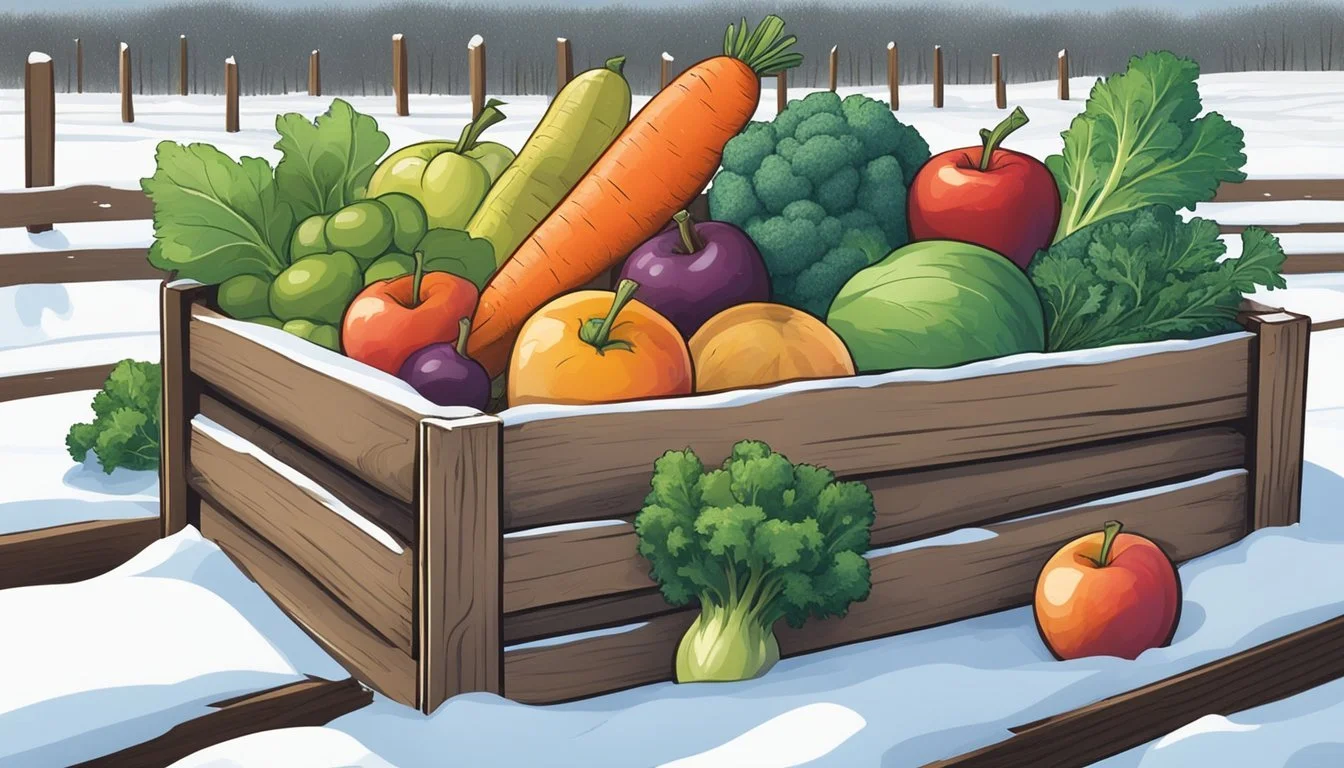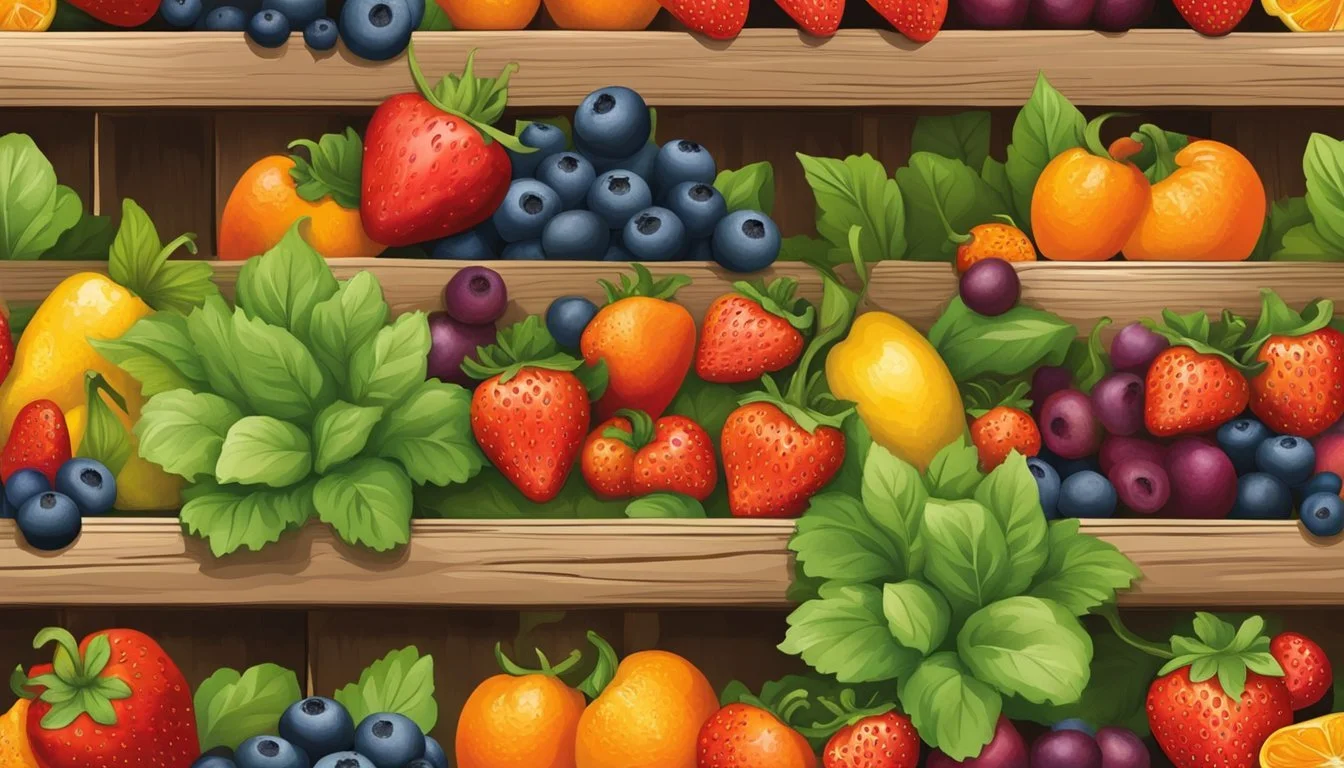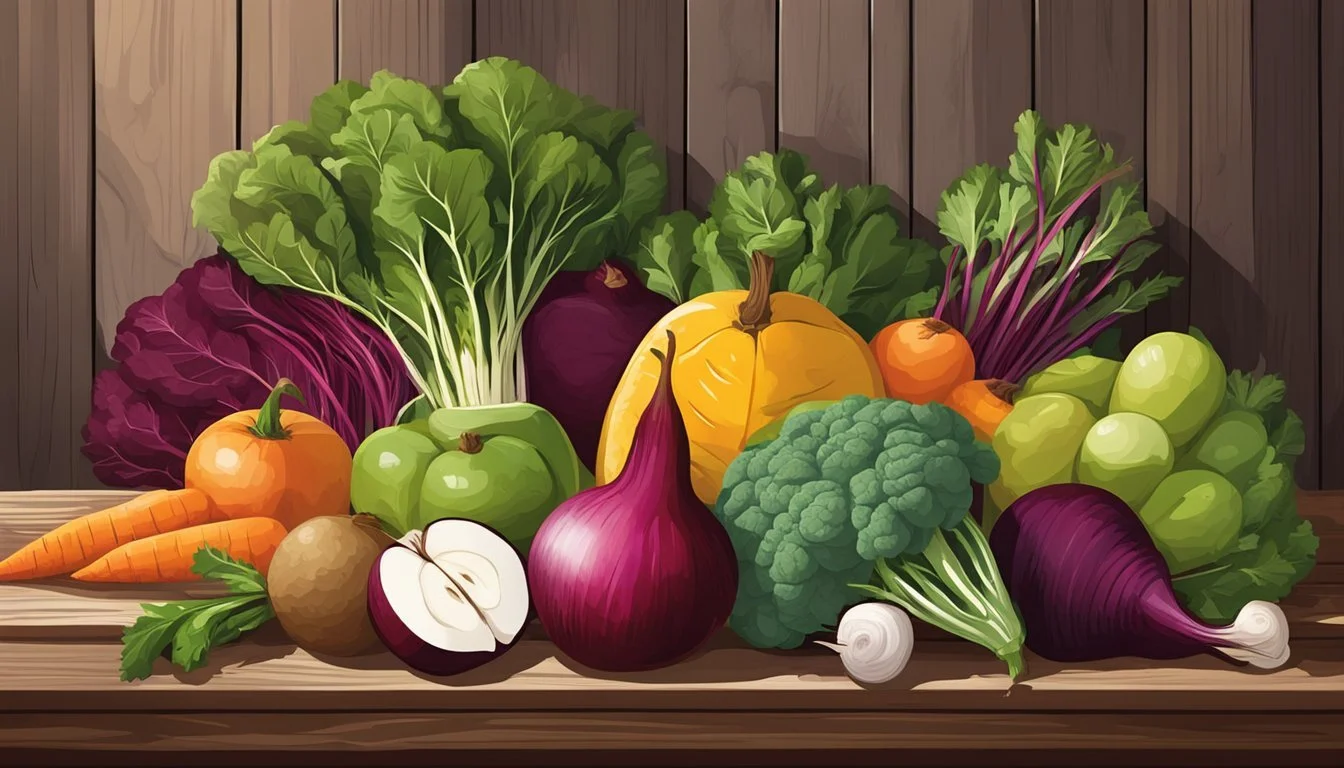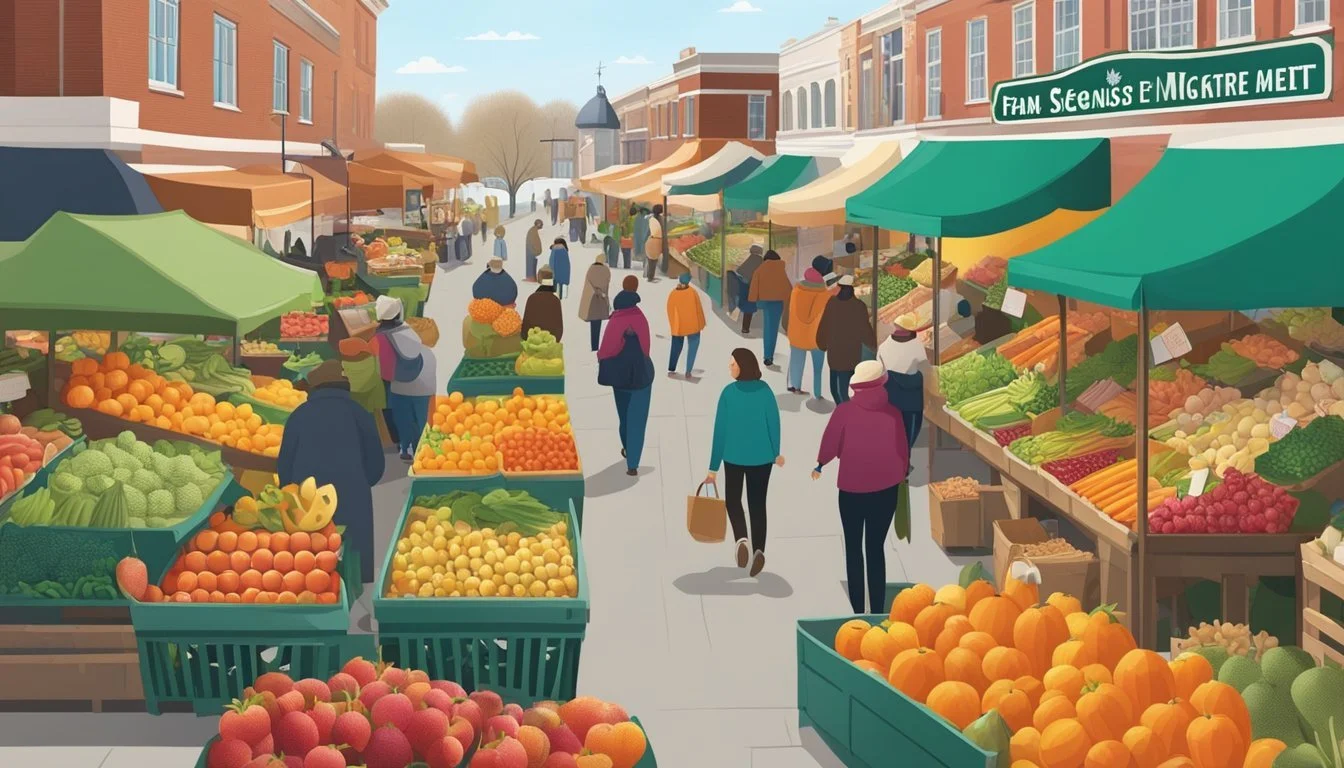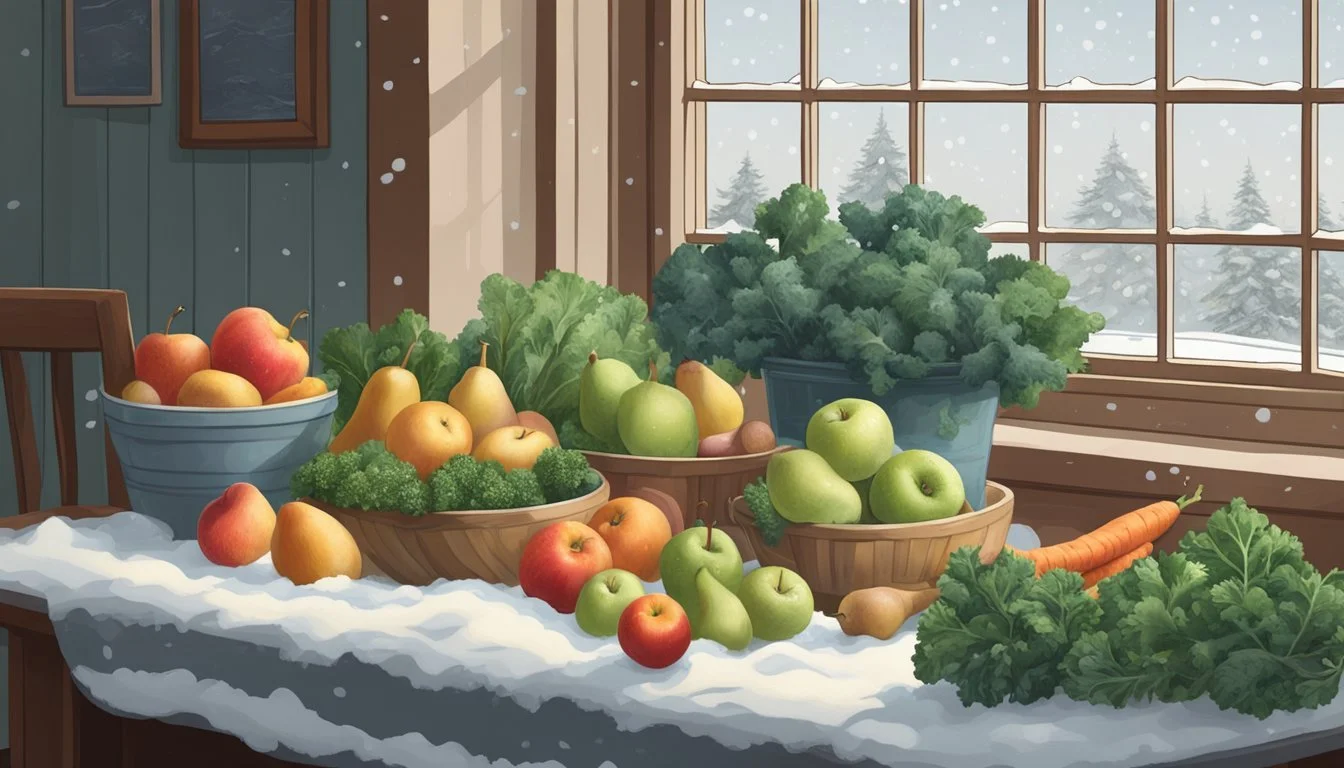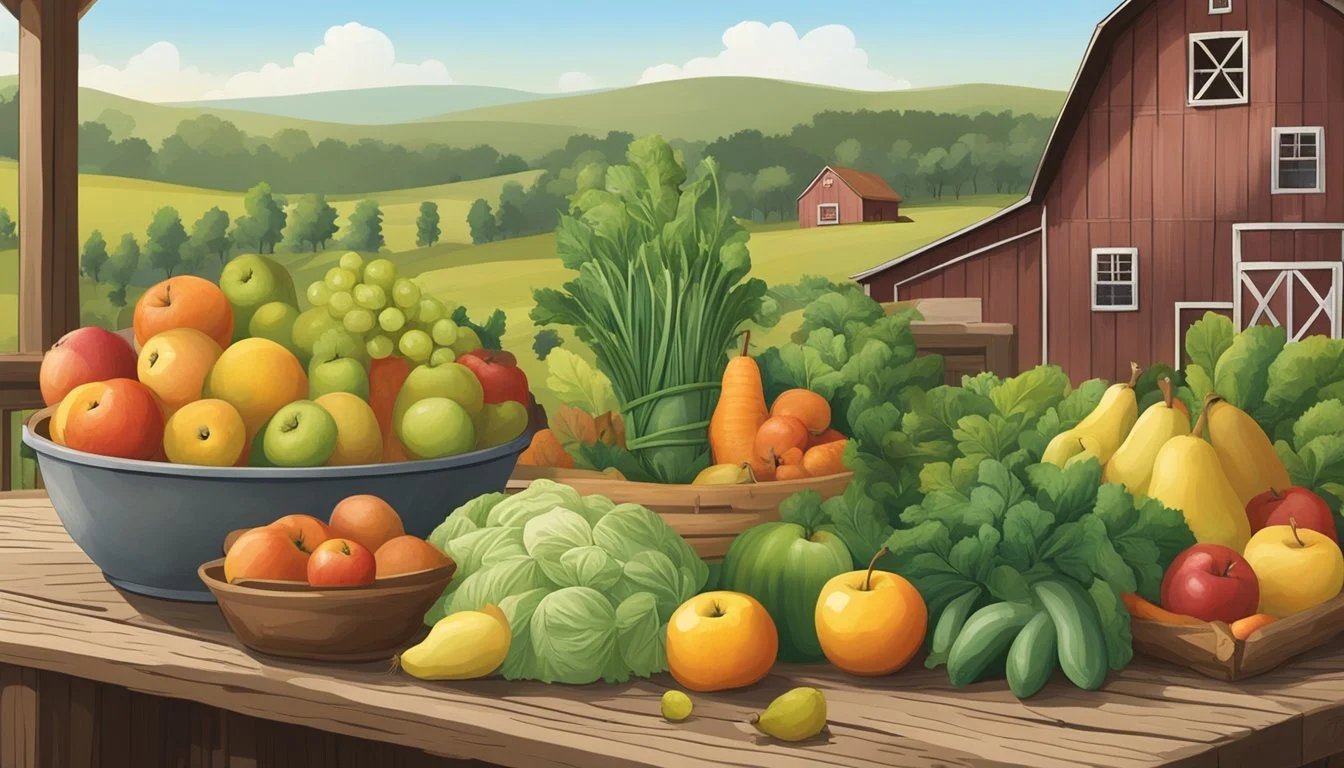Illinois Seasonal Fruit & Vegetables in February
A Guide to Local Produce
This Article is Part of our Illinois Seasonal Fruit & Veg Calendar
In the heart of winter, Illinois continues to offer a variety of fresh, seasonal produce that can be enjoyed despite the chilly temperatures. February in the Prairie State is a time when root vegetables and hardy greens are abundant, reflecting the adaptability of local farmers to the region's cold weather patterns. Seasonal eating during this month not only supports the local agricultural economy but also ensures that consumers are getting foods at their peak of freshness and nutritional value.
While Illinois may be known for its corn in the summer, the winter months bring about a different bounty respected by both local chefs and health-conscious consumers. Storage crops like potatoes, carrots (how long do carrots last?), and onions remain staples, while the availability of cold weather-grown greens such as kale and collards adds variety to winter menus. The use of hoop houses and other season-extension techniques also allows for the harvest of produce such as beets (how long do beets last?), mushrooms, and brussels sprouts, providing an earthy and wholesome selection for those seeking to incorporate seasonal ingredients into their cooking.
Consumers looking to shop for seasonal produce in February can expect to find these ingredients offering robust flavors and nutrition. Root vegetables can often be stored for long periods without losing their quality, making them a reliable choice during the winter months. Greens harvested during the cold are typically sweeter, having converted starches into sugars to withstand the frost. Thus, even in the depths of winter, Illinois offers a surprising array of produce options that are as delicious as they are nutrient-dense.
Seasonal Produce Overview
In February, Illinois brims with a variety of fresh seasonal produce. This period marks a high time for certain vegetables and fruits, which offer peak flavor and nutritional benefits.
Benefits of Seasonal Eating
Consuming produce during their peak season can provide enhanced taste and higher nutritional content compared to off-season counterparts. Seasonal fruits and vegetables are often harvested at the optimum time, ensuring a fresher, more flavorful experience. In Illinois during February, individuals have the advantage of incorporating a range of citrus fruits and cruciferous vegetables into their diet, which are both plentiful and at their best quality.
Understanding Illinois's Seasonality
The cold winter month of February sets the stage for certain robust vegetables and bright citrus fruits to thrive. In Illinois, root vegetables and various members of the cruciferous family, such as broccoli (how long does broccoli last?) and Brussels sprouts, are still available from local harvests and often from storage. These vegetables can withstand the cooler temperatures, providing fresh options for consumers.
Citrus fruits are a highlight of the season, with an abundance featuring in grocery stores and markets. Among these, oranges, grapefruits, and lemons stand out, delivering not only fresh flavors but also a boost of Vitamin C during the winter months. Additionally, despite being the off-season for most berries and soft fruits, stores may still carry them, often sourced from different climates or stored from previous seasons.
Key Seasonal Fruits
In February, Illinois embraces a limited but vibrant selection of seasonal fruits, with citrus fruits brightening up the winter markets, and a few other fruits remaining available despite the chilly climate.
Citrus Fruits
Citrus fruits reach their peak during the winter months, offering freshness and a burst of flavor. In Illinois, consumers can find a variety of citrus fruits, with the following being particularly notable:
Lemons: Known for their bright yellow color and tart flavor, lemons are versatile, serving culinary needs from baking to cooking to beverage preparation.
Oranges: Sweet and juicy, oranges are a staple in winter fruit consumption. They provide vitamin C, which is crucial during the cold season.
Grapefruits: With a tangy and slightly bitter taste, grapefruits are commonly enjoyed on their own or in fruit salads.
Blood Oranges: Distinct for their deep red flesh, they offer a unique sweet flavor with a hint of raspberry-like taste.
Limes: Smaller in size but packed with zest, limes are often used to add a tangy punch to dishes and drinks.
Other Winter Fruits
While citrus fruits dominate the winter season, there are other fruits that maintain their presence during February in Illinois:
Pears: Subtly sweet, with a soft yet grainy texture, pears can be found in grocery stores and are perfect for both raw and cooked applications.
These fruits represent what is seasonally available in Illinois during the cold month of February, providing not only delicious options for consumers but also important nutrients to help maintain health during the winter.
Key Seasonal Vegetables
In February, Illinois residents can enjoy a variety of seasonal vegetables that not only withstand the cooler temperatures but also offer enriching nutrients and flavors to winter cuisine.
Cruciferous Vegetables
Cruciferous vegetables thrive in the cool winter months of Illinois. Broccoli and Brussels sprouts are excellent during this season; these vegetables are known for their cancer-fighting properties and can be incorporated into a variety of dishes. Cauliflower (how long does cauliflower last?), another hearty option, offers versatility and can be used in recipes ranging from soups to roasted sides.
Cabbage: Durable and diverse, perfect for slaws and ferments.
Cauliflower: Ideal for roasting or as a rice substitute.
Broccoli: Great for stir-fries or steamed as a side.
Brussels Sprouts: Best roasted to bring out a nutty flavor.
Root Vegetables
The chill of February keeps root vegetables in prime condition, storing energy and sugar that makes them particularly flavorful. Carrots, enjoyed for their sweetness when cooked, are a staple. Beets, with their deep, earthy flavor and vibrant color, are also on offer and can be used in everything from salads to desserts.
Carrots: Sweet and crunchy, suitable for both raw and cooked dishes.
Beets: Earthy taste, perfect for salads, juices, or roasting.
Turnips: Starchy texture, good mashed or roasted.
Radishes: Peppery bite, eaten raw or pickled.
Garlic: Aromatic and flavorful, indispensable for cooking.
Leeks: Mild onion-like taste, used in soups and sautéed dishes. (What Wine Pairs Best with Sautéed Dishes)
Onions: The foundation of savory cooking, essential in many recipes.
Leafy Greens
Even in the heart of winter, some leafy greens are still in season, offering fresh flavors and a touch of spring to come. Kale and collard greens (how long do collard greens last?) are hardy greens that can withstand frost, which makes them sweeter. They are well-suited for sautés and soups. Spinach and arugula (how long does arugula last?) are more tender but can be grown in Illinois' protected environments during the winter, providing a fresh, nutritious addition to salads and sandwiches.
Kale: Robust and nutrient-dense, great for chips or sautés.
Collard Greens: Best braised, full of vitamins and minerals.
Spinach: Tender and versatile, excellent for salads or cooked dishes.
Arugula: Peppery flavor, adds a kick to salads and toppings.
Seasonal Recipes and Preparation
During February in Illinois, utilizing seasonal produce can lead to a wealth of flavorful and nutritious recipes. This month, emphasis on citrus fruits and hearty vegetables can inspire a variety of dishes, ranging from vibrant salads to warming soups.
Salads and Sides
Salads in February benefit from the inclusion of citrus fruits, which add a refreshing burst of flavor. Winter Citrus Salad with slices of navel oranges, ruby grapefruits, and blood oranges offers a colorful side dish loaded with vitamins. For a warm side, Roasted Broccoli and Roasted Brussels Sprouts, seasoned with garlic and tossed in olive oil, can be a savory accompaniment to any main dish.
Ingredients:
Leafy greens
Citrus fruits
Broccoli
Brussels sprouts
Main Dishes
Hearty vegetables like winter squash become the star in main dishes. A Stuffed Acorn Squash filled with wild rice (how long does wild rice last?), herbs, and cranberries makes a satisfying entrée. Alternatively, a savory Roasted Vegetable Medley incorporating local roots and squash can be paired with lean proteins for a balanced meal.
Preparation:
Roast at 400°F until tender
Stuff squash with pre-cooked rice mixture
Soups and Stews
Soups are ideal for the cold February weather. A Butternut Squash Soup, pureed until smooth and seasoned with a hint of nutmeg (how long does nutmeg last?), provides warmth and nutrition. For more robust fare, a Root Vegetable Stew with chunks of turnips and carrots can be slowly simmered to develop deep flavors.
Cooking Tip:
Simmer soups and stews on low heat to meld flavors
Desserts and Smoothies
Desserts using citrus fruits are both sweet and tart. Simple yet delicious, a Lemon Citrus Curd can be used to fill tarts or as a topping for desserts. For a healthier option, Citrus Fruit Smoothies blended with Greek yogurt provide a creamy and invigorating drink.
Recipe Suggestion:
Blend citrus fruits with a touch of honey and Greek yogurt for a quick smoothie
Local Market and Farm Guide
In Illinois, February offers a variety of seasonal produce that can be sourced directly from local markets and farms. These venues are essential for obtaining fresh, nutritious fruits and vegetables during this winter month.
Finding Local Produce
Shoppers in Illinois have the convenience of visiting farmers' markets across the state, which are often stocked with winter crops. These markets provide a direct link between consumers and local farmers. A shopper can pin locations and individual market details on Pinterest or other bookmarking sites for ease of access and planning.
Local farms may also offer storefronts or farm stands even in the colder months, presenting an opportunity to buy produce like broccoli, carrots, and sweet potatoes. Many Illinois stores, including those in Chicago’s vibrant food scene, source from these farms to ensure the freshness of their offerings.
To find these markets and farm stands, one can utilize resources such as the Illinois Farmers Market Association’s seasonal app. This tool helps locate Illinois produce at its peak, bringing farm-fresh quality to the local community's table.
Seasonal Eating Tips
In February, Illinois residents delight in seasonal produce that is exceptional for both taste and nutrition. The key to maximizing the freshness of these fruits and vegetables lies in proper storage techniques and innovative cooking methods.
Storage and Preservation
Proper storage and preservation methods are essential for maintaining the quality and extending the shelf life of seasonal produce.
Apples: Store apples in a cool, dark place or refrigerate them in a crisper drawer. They can last several weeks when stored properly.
Root Vegetables (such as carrots): Keep them in a cool, dark, and well-ventilated area in moisture-proof bags.
Collard Greens: Refrigerate in a plastic bag with air holes and use within five to seven days.
Citrus Fruits (like blood oranges, lemons, and limes): Store them at room temperature for a week or in the refrigerator for longer shelf life.
For preserving:
Pickling: Vegetables like carrots and cauliflower can be pickled to extend their usage well beyond their season.
Freezing: Blanch and freeze greens like collards to keep a stock of healthy greens available any time.
Creative Cooking Techniques
Exploring creative cooking techniques can both enhance the natural flavors of seasonal ingredients and add variety to winter meals.
Roasting: Root vegetables can be peeled, diced, and roasted to bring out their natural sweetness. Try roasting carrots with a drizzle of olive oil and a sprinkle of herbs.
Grilled: For a smoky twist, one can grill citrus fruits to accompany a salad or to add a charred flavor to recipes.
Some recipe ideas:
Salads: Toss blood oranges with a spring mix, add roasted nuts (how long do nuts last?), and a vinaigrette for a refreshing salad.
Side Dishes: Collard greens can be sautéed with garlic as a nutritious side dish.
Desserts: Apples can be baked into pies, or cooked down for compotes and sauces.
Conclusion
In Illinois, the month of February presents a limited but valuable selection of seasonal produce. Although the winter climate can be challenging for growing, consumers can still find fresh, locally-grown fruits and vegetables.
Fruits available tend to include storage-friendly varieties and those with a later winter harvest. These often comprise:
Apples
Kiwi
Vegetables that withstand the cold and can be found during this time include hearty greens and stored harvests. Some of these are:
Brussels sprouts
It is important for consumers to recognize the benefits of purchasing seasonal produce. Not only does it support local agriculture, but it also tends to be fresher and more flavorful. February’s offerings, albeit limited, are no exception.
Residents in Illinois utilizing seasonal fruits and vegetables can expect robust flavors and the knowledge that they are adapting their diets to the natural growing cycles of their region. This practice encourages sustainable consumption and can lead to a more environmentally conscious community.


